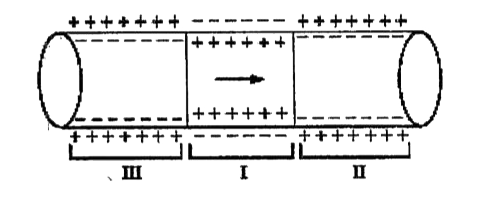Resting membrane potential will begreater in
Large size fibre
Small size fibre
both a and b
None o these
To answer the question regarding which fiber has the greatest resting membrane potential, we can follow these steps:
1. Understand Resting Membrane Potential:
- The resting membrane potential is typically around -70 millivolts in neurons. This value is determined by the distribution of ions across the cell membrane, particularly sodium (Na⁺) and potassium (K⁺) ions.
2. Identify the Role of Ions:
- During resting potential, potassium ions are predominantly found inside the cell, while sodium ions are more concentrated outside. The movement of these ions across the membrane contributes to the negative charge inside the cell.
3. Consider Fiber Types:
- Different types of nerve fibers (e.g., myelinated vs. unmyelinated, thick vs. thin) may have variations in their ionic concentrations, but the resting membrane potential itself does not significantly vary based on the size or type of the fiber.
4. Conclude on Ionic Concentration:
- The resting membrane potential is primarily influenced by the ionic concentrations rather than the physical characteristics of the nerve fibers. Therefore, regardless of whether the fiber is thick or thin, the resting membrane potential remains consistent around -70 millivolts.
5. Final Answer:
- Since the resting membrane potential does not vary significantly with the type of fiber, the answer to the question is that none of the options provided would be correct in indicating which fiber has a greater resting membrane potential.
- The resting membrane potential is typically around -70 millivolts in neurons. This value is determined by the distribution of ions across the cell membrane, particularly sodium (Na⁺) and potassium (K⁺) ions.
- During resting potential, potassium ions are predominantly found inside the cell, while sodium ions are more concentrated outside. The movement of these ions across the membrane contributes to the negative charge inside the cell.
- Different types of nerve fibers (e.g., myelinated vs. unmyelinated, thick vs. thin) may have variations in their ionic concentrations, but the resting membrane potential itself does not significantly vary based on the size or type of the fiber.
- The resting membrane potential is primarily influenced by the ionic concentrations rather than the physical characteristics of the nerve fibers. Therefore, regardless of whether the fiber is thick or thin, the resting membrane potential remains consistent around -70 millivolts.
- Since the resting membrane potential does not vary significantly with the type of fiber, the answer to the question is that none of the options provided would be correct in indicating which fiber has a greater resting membrane potential.
Similar Questions
Knowledge Check
Resting membrane potential is maintained by
AhormonesBneurotransmittersCions pumpsDnone of the aboveResting membrane potential is maintained by
AhormonesBneurotransmittersCions pumpsDnone of the aboveResting membrane potential is maintained by
AhormonesBneurotransmittersCions pumpsDnone of the above
A typical value of resting membrane potential is
View SolutionIn the retina, the membrane potentials are first generated in:
View SolutionThe image illustrates the movement of an impulse in a nerve fibre. The labels I, II and III, represent the changes present on either sides of the membrane. When an action potential is generated, because of movement of ions, a positive charge inside and negative charge outside is established. Immediately after, the membrane returns to its original condition and is said to be repolarized. Resting membrane potenetial is established when the membrane gains positive charge outside and negative charge inside i.e., the memebrane is said to be polarized.

The information in which alternative matches the labels with its respective names correctly ?
View SolutionMembrane potential of a cell forms
View SolutionThe value of resting membrane potential is
View Solution
